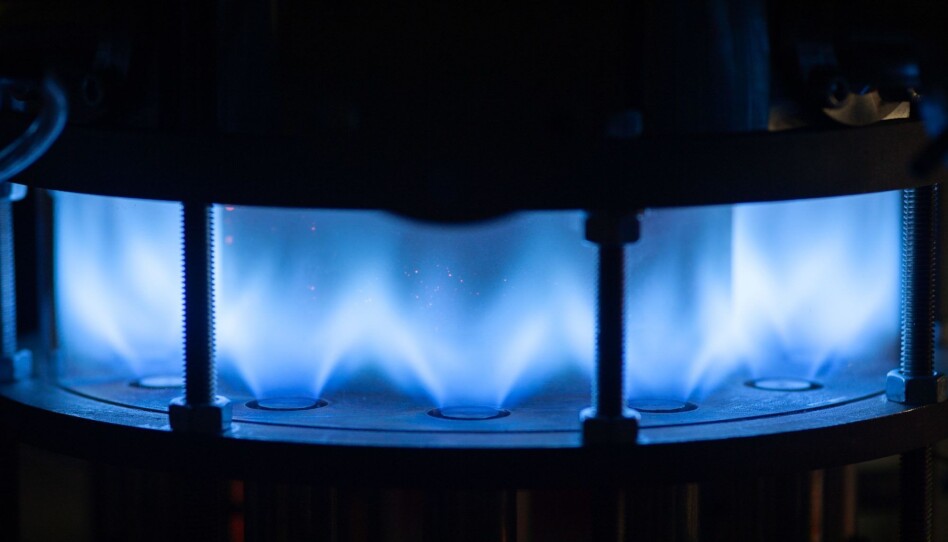This article is produced and financed by NTNU Norwegian University of Science and Technology - read more

Ammonia may hold key to greener combustion
One way to reduce flight shame may lie in a ring of flames. And in the gas that’s generated in an outhouse.
The whole world is eager to have a more environmentally friendly way to fly. While some folks are trying to cover plane roofs with solar cells or to fill fuel tanks with used frying oil, researcher Nicholas Worth from NTNU is studying a ring of flames to the tune of millions of euros from the EU.
Polluting less
Worth’s research may lead to lower pollution emissions from today’s aircraft engines or to making environmentally friendly fuel more economical.
Some of the most harmful exhaust particles are nitrogen oxides. This is an odourless and colourless gas that forms when engines burn at high temperature.
This type of pollution can trigger lung function problems for people with asthma. At worst, it can trigger asthma.
Diesel emits more of this type of pollution than gasoline. Electric cars emit nothing. Airplanes emit a lot.
Lots of pollution at airports
“You’ll find a lot of these fumes at airports. On top of that you have greenhouse gas emissions that come from the combustion of the fuel itself,” Worth says.
While some people believe that greenhouse gas emissions from aircraft account for two per cent of global emissions, others believe that the figure is higher than ten per cent. Perhaps no one can come up with an exact figure, but seen from an individual basis, flights are a source of high emissions per person.
To understand how a ring of flames can lead to greener aircraft transport, we need to take a tiny dive into an aircraft engine.

Aircraft powered by a form of paraffin
Airplanes have a gas turbine engine powered by aviation gasoline. This is derived from petroleum and, greatly simplified, can be referred to as lamp oil, paraffin or kerosene. It’s easy to light, works really well and isn’t very environmentally friendly.
This is exactly where Worth’s work comes in.
Regardless of whether an aircraft is powered by lamp oil, hydrogen, aviation gasoline or cooking oil, the gases that are produced when it is burned at high temperature are what create energy and pressure to lift the plane.
In the aircraft engine, the fuel is burned in a ring-shaped combustion chamber containing a number of individual flames.
Unstable flames use more gasoline
The shape of the chamber can make the flames that consume the fuel change shape, flicker more, or become completely unstable. In the language of physics, this is called thermoacoustic instability.
Flames that become unstable will make more sound, and the sound waves created will affect the other flames in the chamber. This makes it more difficult to design aircraft engines that have low emissions than high ones.
To date, the process of studying a flame has been done one flame at a time. By contrast, Worth studies between 12 and 18 flames in a ring, in a variety of combustion chambers and with various types of fuels such as methane gas, hydrogen and ammonia.
“Combustion chambers come in all kinds of sizes. In helicopters, they’re small, in jets they’re big and in power stations huge. So far, no one has been able to predict whether a small change in the chamber will result in a change for the entire engine. Or how the flames in the chamber change as the fuel changes,” says Worth.
International breakthrough
Worth has already gotten results. His work is considered an international breakthrough, and could be decisive for whether engine manufacturers can develop new engines with low greenhouse gas and nitrogen oxide emissions.
“Having a basic understanding of the physics of the instability created by flames is necessary so that we can develop tools to control them, and avoid instability when designing engines. Aviation gasoline burns in one way, whereas hydrogen burns in a completely different way. Understanding this will make it easier to design engines that can burn different types of fuel, for example. This will result in less pollution from the exhaust,” Worth says.
Yara one of world’s largest manufacturers
Hydrogen is gas that it is created from water, and several researchers consider it to be the best alternative for environmentally friendly fuel because it can be produced and used entirely without greenhouse gas emissions. Worth, on the other hand, believes that ammonia may have even more potential than hydrogen as a gas turbine engine fuel.
Ammonia is a colourless gas that forms the basis for modern fertilizer production. This is also the gas that forms when urine is left standing, such as in an outhouse.

“Ammonia is easier to transport, easier to store, and less pressure is required to convert it to liquid form than hydrogen. Ammonia also burns more slowly than hydrogen,” Worth says.
The Norwegian company Yara is among the world’s largest manufacturers of ammonia. The Norwegian state is Yara’s largest shareholder.
“The research conducted at NTNU will help reduce the emission of pollutants from aircraft engines, and will allow greater fuel flexibility for stationary gas turbines used for power generation,” Worth said.
A large part of the greenhouse gas emissions from Norway come from gas-powered power stations on offshore oil platforms. This natural gas is a fossil fuel.
“If ammonia or hydrogen were used instead of natural gas, then this would be an excellent way to reduce Norway’s greenhouse gas emissions,” Worth said.
Watch Nicholas Worth talk about his research in a YouTube video:


































